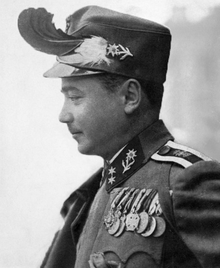Dollfuss
| Engelbert Dollfuss | |
|---|---|

Dollfuss pictured in Kaiserschützen uniform, 1933.
|
|
| 10th Chancellor of Austria | |
|
In office 20 May 1932 – 25 July 1934 |
|
| President | Wilhelm Miklas |
| Deputy |
Franz Winkler Emil Fey Ernst Rüdiger Starhemberg |
| Preceded by | Karl Buresch |
| Succeeded by | Kurt Schuschnigg |
| Foreign Minister of Austria | |
|
In office 20 May 1932 – 10 July 1934 |
|
| Chancellor | himself |
| Preceded by | Karl Buresch |
| Succeeded by | Stephan Tauschitz |
| Federal leader of the Fatherland Front | |
|
In office 20 May 1933 – 25 July 1934 |
|
| Deputy | Ernst Rüdiger Starhemberg |
| Preceded by | None |
| Succeeded by | Ernst Rüdiger Starhemberg |
| Personal details | |
| Born | October 4, 1892 Texingtal, Lower Austria, Austria, Austro-Hungary |
| Died | July 25, 1934 (aged 41) Vienna, Austria |
| Political party |
Christian Social Party Fatherland Front |
| Spouse(s) | Alwine Dollfuß |
| Religion | Catholicism |
Engelbert Dollfuss (German: Engelbert Dollfuß, IPA: [ˈɛŋəlbɛʁt ˈdɔlfuːs]; October 4, 1892 – July 25, 1934) was an Austrian Christian Social and Patriotic Front statesman. Having served as Minister for Forests and Agriculture, he ascended to Federal Chancellor in 1932 in the midst of a crisis for the conservative government. In early 1933, he shut down parliament, banned the Austrian Nazi party and assumed dictatorial powers. Suppressing the Socialist movement in February 1934, he cemented the rule of “austrofascism” through the authoritarian First of May Constitution. Dollfuss was assassinated as part of a failed coup attempt by Nazi agents in 1934. His successor Kurt Schuschnigg maintained the regime until Adolf Hitler's annexation of Austria in 1938.
He was born in Texing in Lower Austria to unmarried mother Josepha Dollfuss and her lover Joseph Weninger. The couple, of peasant origin, was unable to get married due to financial problems. A few months after her son’s birth, Josepha married landowner Leopold Schmutz in Kirnberg, who did not, however, adopt Engelbert as his own child. Dollfuss, who was raised as a devout Roman Catholic, received a scholarship for the minor seminary of the Archdiocese of Vienna in Hollabrunn in 1904. Having obtained his Matura degree in 1913, he first decided to continue his studies at the Vienna seminary but subsequently switched to study law at the University of Vienna.
...
Wikipedia
